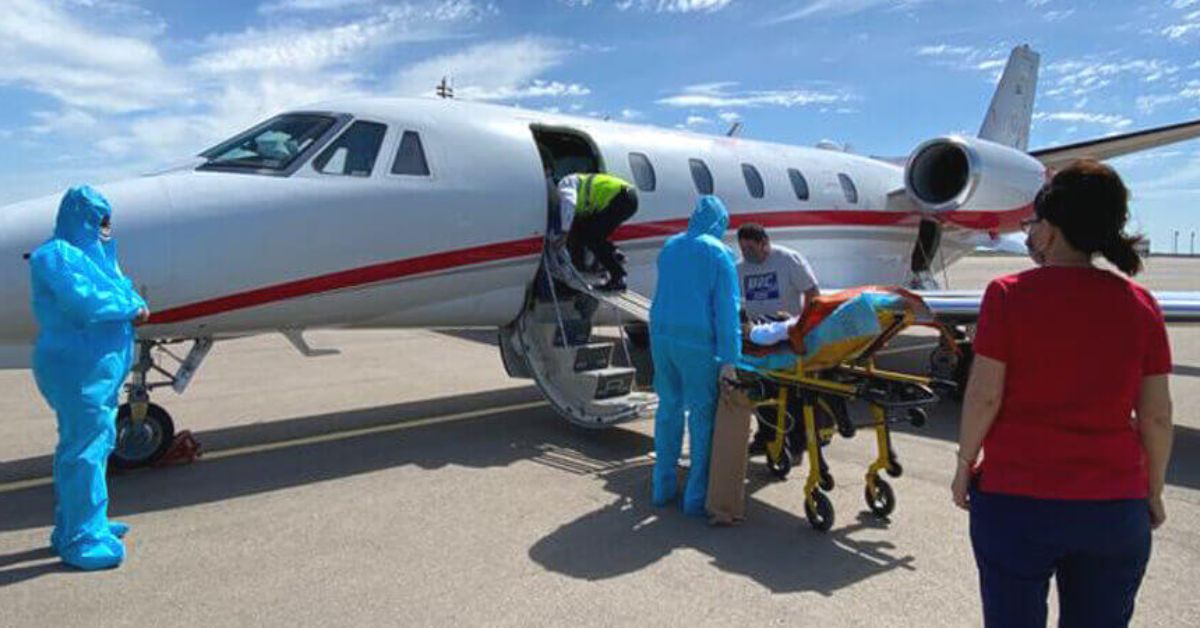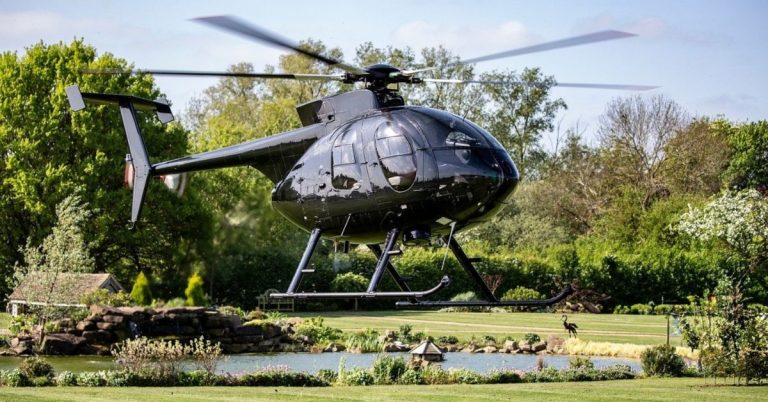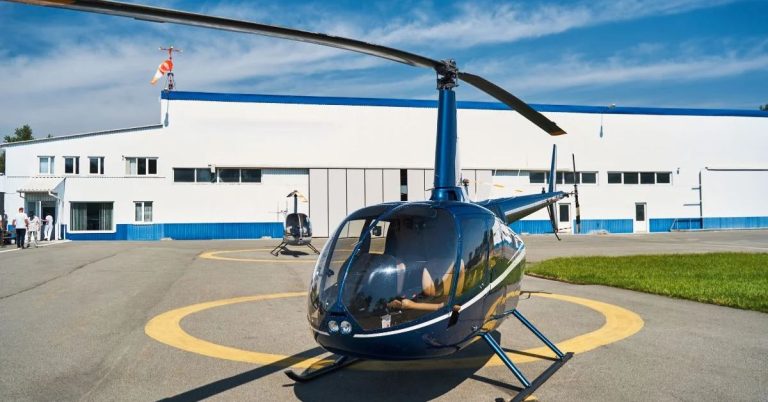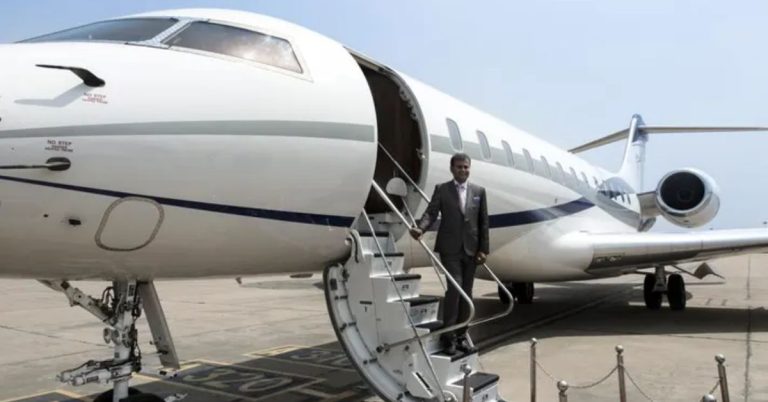Best air ambulance service in India have become an essential part of the country’s emergency healthcare delivery system, offering rapid medical evacuation and critical care transport for patients in urgent need. The air ambulance India sector is experiencing significant growth, propelled by increasing healthcare awareness, a rise in lifestyle-related diseases, and advancements in medical infrastructure. Industry reports indicate that the Indian air ambulance services India market is expanding at a Compound Annual Growth Rate (CAGR) of approximately 15-20%, demonstrating the growing demand for efficient and reliable emergency air ambulance solutions. This surge underscores the critical role of medical air transport in improving patient outcomes and accessibility across diverse geographic regions.
Air ambulance India services encompass fixed-wing aircraft, helicopters, and chartered jets equipped with advanced life support systems to facilitate emergency air medical services. These services are crucial for regions with limited access to advanced healthcare facilities, especially in geographically challenging areas such as the Himalayas, northeastern states, and remote rural locations. The ability to provide rapid transport significantly improves patient survival rates and clinical outcomes.
The market is broadly divided between government-operated and private air ambulance providers. While public services typically focus on disaster response and military medical evacuation, private air ambulance services India have expanded rapidly by offering tailored solutions that include 24/7 availability, state-of-the-art onboard medical equipment, and specialized medical teams. Leading private providers have established extensive networks, covering metropolitan hubs as well as tier-2 and tier-3 cities.
Regulatory frameworks from the Directorate General of Civil Aviation (DGCA) and the Ministry of Health and Family Welfare govern the operational standards of air ambulance services India. These regulations emphasize safety, medical crew qualifications, and aircraft maintenance, ensuring a high standard of care during air medical transport.
As India’s healthcare system continues to modernize, air ambulance services remain indispensable for time-critical patient transfers, organ transplants, and inter-hospital transfers. The synergy between advanced aviation technology and emergency medical care positions air ambulance India as a cornerstone of modern healthcare logistics.
Best Air Ambulance Service in India
Private aviation is a critical enabler in delivering the best air ambulance service in India, significantly enhancing the speed, accessibility, and quality of emergency medical air transport. The private air ambulance sector in India comprises fixed-wing jets and helicopters, selected from various types of private jets and fully equipped to provide advanced life support and continuous patient monitoring during transit.
The use of private jet ambulance services enables rapid inter-city and international transfers, while helicopters provide crucial access to remote or congested areas, offering versatile solutions for emergency medical air transport. These capabilities are fundamental to delivering the best air ambulance service in India, ensuring patients receive timely critical care irrespective of location.
Technological integration has further strengthened private air ambulance services India. Telemedicine connectivity, AI-assisted patient monitoring, and state-of-the-art onboard equipment such as portable ventilators and defibrillators are now standard features. Additionally, The rise of luxury air ambulance options combines clinical excellence with enhanced comfort and privacy, often mirroring the amenities found in billionaire luxury private jets and catering to high-net-worth patients and corporate clients.
Leading Best Air Ambulance Services in India:
- Med-Trans Air Ambulance
Operates a diverse fleet of fixed-wing jets and helicopters, offering 24/7 emergency medical air transport with advanced life support systems and experienced critical care teams. - Global Air Ambulance
Known for rapid response and extensive geographic coverage, Global Air Ambulance provides customized air medical services with telemedicine integration and ICU-level onboard care. - Flyjet Air Ambulance
Specializes in luxury air ambulance services with fully equipped jets that ensure patient comfort alongside comprehensive medical support for domestic and international transfers. - Pronto Air Ambulance
Focuses on critical care transport, employing medically staffed helicopters and jets with real-time communication capabilities for seamless patient handover. - Aster Air Ambulance
Part of a reputed healthcare network, Aster offers reliable air ambulance solutions emphasizing advanced life support and quick mobilization.
Cost and Service Optimization
The air ambulance cost India varies based on aircraft type, distance, onboard medical equipment, and crew specialization. Providers optimize costs through fleet diversity and strategic base locations, ensuring rapid deployment while maintaining high standards of care.
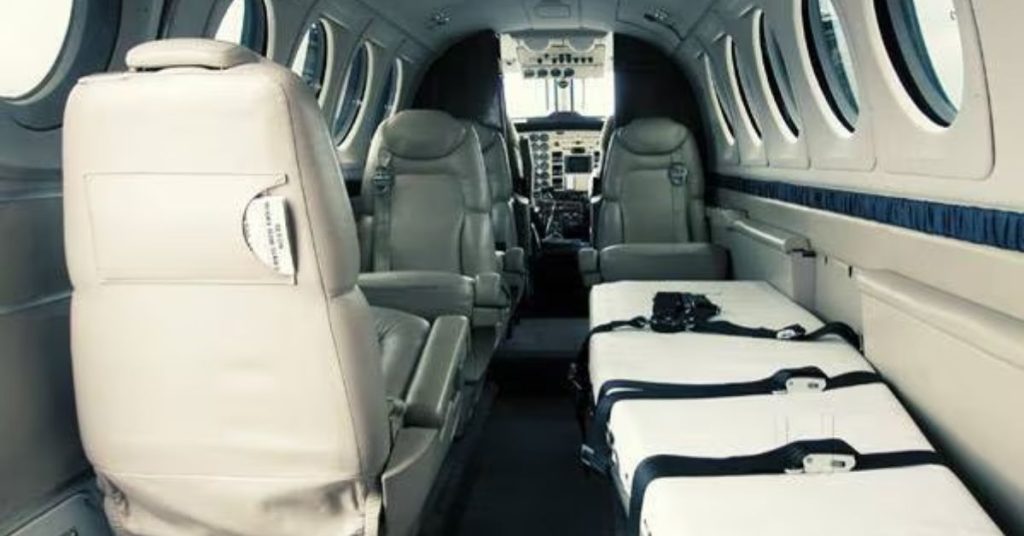
In summary, the best air ambulance service in India integrates cutting-edge private aviation technology with expert medical care, enabling efficient, safe, and patient-centric emergency transport across the country.
Comparative Analysis of Top Air Ambulance Services in India
The Indian air ambulance market features several private providers distinguished by fleet size, medical capabilities, response time, geographic reach, and service quality. A comparative analysis of leading players enables stakeholders to identify the best air ambulance service in India based on operational efficiency, clinical excellence, and cost-effectiveness.
Criteria for Comparison:
- Fleet Composition and Size: Availability of fixed-wing jets and helicopters to serve diverse geographic and clinical needs.
- Medical Facilities Onboard: Advanced life support systems, onboard ICU capabilities, and presence of specialized medical teams.
- Response Time: Average mobilization and flight time, critical for patient survival in emergencies.
- Geographic Coverage: Service reach across metropolitan, tier-2, tier-3 cities, and remote areas.
- Accreditations and Compliance: Certification from DGCA and healthcare regulatory bodies ensuring safety and quality.
- Customer Satisfaction and Success Rates: Patient testimonials, clinical outcomes, and service reliability.
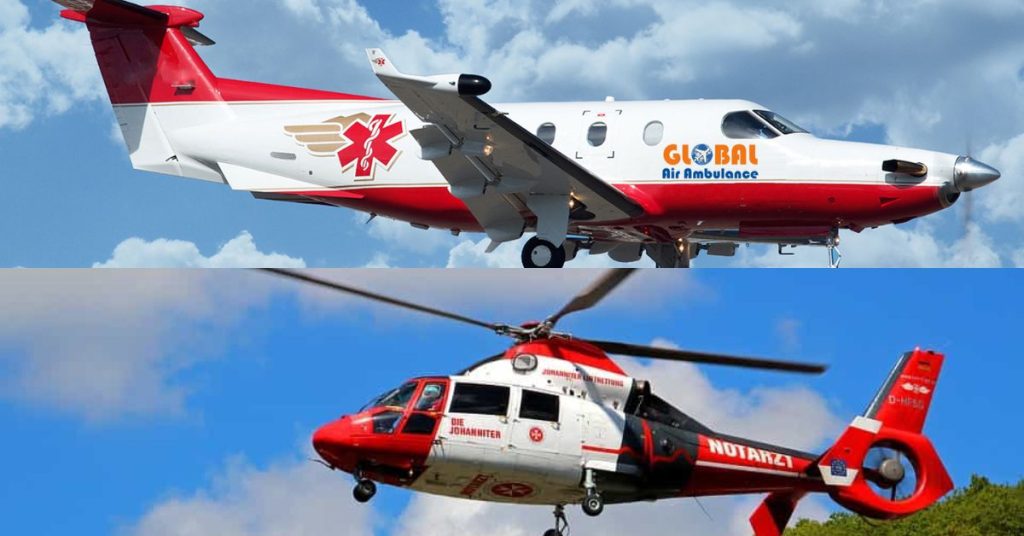
Leading Providers:
- Med-Trans Air Ambulance
Med-Trans boasts one of the largest fleets comprising both fixed-wing aircraft and helicopters, allowing rapid response across India. Their medical teams are staffed with intensivists, paramedics, and nurses trained in critical care. The service covers over 150 cities and has an average response time under 2 hours in urban centers. Med-Trans holds DGCA accreditation and adheres strictly to international medical evacuation standards. - Global Air Ambulance
Known for its wide network and 24/7 availability, Global Air Ambulance operates specialized aircraft equipped with ICU-grade medical equipment. Their service emphasizes real-time telemedicine integration and has a strong presence in northern and eastern India. Response times average around 90 minutes, with robust coverage extending to remote regions. - Flyjet Air Ambulance
Flyjet focuses on luxury air ambulance services, combining patient comfort with comprehensive medical care using some of the best private jets in the industry. Their fleet includes modern jets outfitted with noise reduction and customizable interiors, ideal for high-net-worth individuals requiring international transfers. Operational bases in Mumbai, Delhi, and Bangalore ensure prompt dispatch, with competitive pricing. - Pronto Air Ambulance
Pronto excels in helicopter ambulance services, targeting fast response in congested metropolitan areas and difficult terrains. Their fleet is optimized for short-range, point-to-point transfers, supported by a dedicated ground team for seamless handoffs. The company boasts ISO certification and a high success rate in trauma patient transfers. - Aster Air Ambulance
Leveraging the healthcare network of Aster DM Healthcare, Aster Air Ambulance offers integrated medical air transport solutions with advanced onboard life support and specialized medical teams. Their operations focus on South India with expanding coverage, emphasizing coordination with hospital facilities for expedited care.
Quantitative Metrics:
| Provider | Fleet Size (Jets/Helicopters) | Avg. Response Time | Geographic Reach (Cities) | Accreditation | Approx. Cost Range (INR) |
|---|---|---|---|---|---|
| Med-Trans | 10/5 | 1.5 – 2 hours | 150+ | DGCA, NABH | ₹3,00,000 – ₹15,00,000 |
| Global Air Ambulance | 8/6 | ~90 minutes | 120+ | DGCA, ISO 9001 | ₹2,50,000 – ₹14,00,000 |
| Flyjet | 5/2 | 2 – 3 hours | 50+ | DGCA | ₹4,00,000 – ₹20,00,000 |
| Pronto | 3/10 | <1 hour | 40+ | DGCA, ISO | ₹1,50,000 – ₹10,00,000 |
| Aster | 4/3 | 2 hours | 60+ | DGCA, NABH | ₹3,00,000 – ₹12,00,000 |
Infrastructure and Logistics:
These providers maintain strategically located operational bases with dedicated maintenance teams to ensure aircraft readiness. The integration of logistics and medical operations enables efficient patient transfers, minimizing downtime between requests. Insurance partnerships and customized service packages further enhance accessibility and affordability.
Cost-Benefit Analysis of Air Ambulance Services
Air ambulance services in India represent a critical yet high-investment segment of emergency medical transport, where understanding the cost-benefit balance is essential for hospitals, insurers, and patients. This section analyzes the key cost drivers, pricing benchmarks, and the tangible benefits of air medical transport compared to conventional ground options.
Cost Components:
The overall air ambulance cost in India is influenced by multiple factors:
- Aircraft Type: Fixed-wing jets incur higher costs than helicopters due to longer range, speed, and onboard medical equipment. Learn more about how fast private jets fly and how that impacts emergency response efficiency.
- Distance and Flight Duration: Longer flights proportionally increase fuel, maintenance, and crew costs.
- Medical Equipment and Crew: Advanced life support systems, ICU equipment, and the presence of specialized medical personnel increase operational expenses.
- Logistics and Base Operations: Maintenance, aircraft readiness, and rapid deployment capabilities add to fixed and variable costs.
- Regulatory Compliance: Meeting DGCA and healthcare standards involves ongoing costs for certifications and quality assurance.
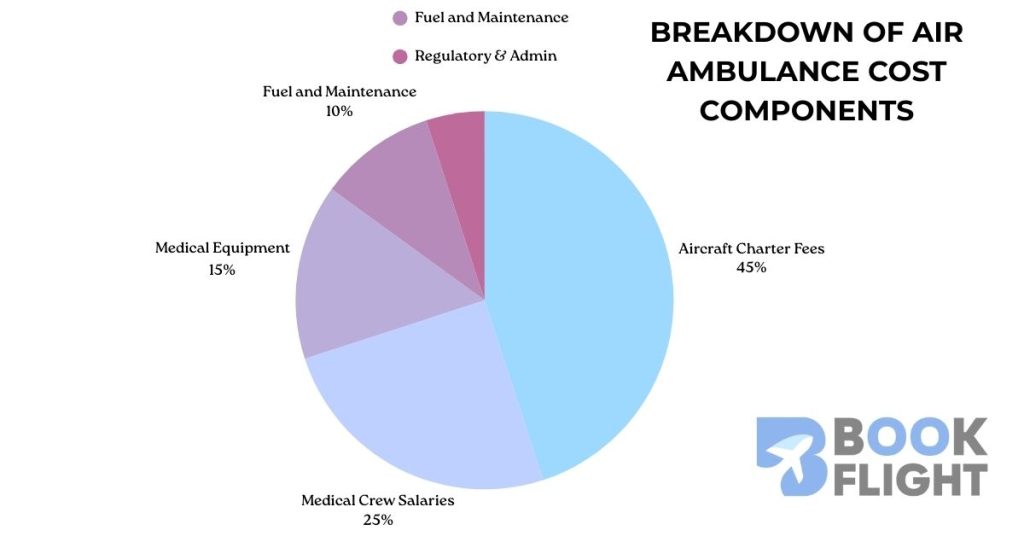
Pricing Benchmarks:
Typical charter fees for air ambulance flights vary widely:
| Flight Type | Approximate Cost Range (INR) | Notes |
|---|---|---|
| Short-range helicopter flight (within city/nearby cities) | ₹1,50,000 – ₹5,00,000 | Ideal for point-to-point transfers in congested or remote areas |
| Domestic fixed-wing jet flight (up to 1000 km) | ₹3,00,000 – ₹12,00,000 | Includes inter-city and regional transfers |
| International air ambulance transfer | ₹15,00,000 and above | Depends on distance, customs clearance, and medical staff |
Benefits Analysis:
- Time Efficiency: Air ambulance services reduce transit time dramatically—up to 70-80% faster than road ambulances—critical for trauma, cardiac events, and organ transplants.
- Improved Clinical Outcomes: Access to onboard ICU-level care and specialized medical teams during transport increases survival rates and reduces complications.
- Access to Remote Areas: Air medical services overcome geographic barriers, ensuring timely treatment for patients in hard-to-reach regions.
- Enhanced Patient Comfort and Safety: Advanced medical equipment and continuous monitoring reduce the risks associated with long transfers.
Return on Investment (ROI):
For hospitals and insurers, investing in or partnering with reputable air ambulance providers offers strategic advantages:
- Reduced Hospital Stay Duration: Quicker transfers to specialized care centers can decrease overall inpatient time and associated costs.
- Enhanced Patient Satisfaction and Brand Reputation: Offering superior emergency transport services improves healthcare delivery perception.
- Cost Offsets via Insurance: Increasing insurance coverage for air ambulance services improves affordability for patients and cost recovery for providers.
Insurance Trends:
India’s evolving health insurance landscape is gradually incorporating coverage for air ambulance services, although policies vary significantly. This trend is expected to lower out-of-pocket expenses, making air ambulance services India more accessible and financially feasible.
Case Example:
A typical transfer of a critical cardiac patient from a tier-2 city to a metropolitan tertiary care center by fixed-wing jet ambulance may cost approximately ₹7,00,000. However, this cost is offset by a 50% reduction in hospitalization days and significantly improved patient prognosis compared to ground transfer.
Emerging Trends and Innovations in the Indian Air Ambulance Sector
The Indian air ambulance sector is undergoing rapid transformation driven by technological innovations, expanding market demand, and evolving healthcare needs. These emerging trends are shaping the future landscape of emergency medical air transport, enhancing efficiency, accessibility, and patient care.
Growing Demand for Luxury Air Ambulance Services
The demand for luxury air ambulance solutions is rising, fueled by increasing healthcare awareness among affluent individuals and corporate clients. These services emphasize patient comfort, privacy, and high-end amenities alongside comprehensive critical care. Providers are customizing interiors with soundproofing, ergonomic medical beds, and tailored in-flight services, setting new standards for medical air transport in India.
Technological Integration: AI, IoT, and Telemedicine
Advanced technologies are increasingly integrated into air ambulance operations. Artificial Intelligence (AI) supports real-time patient monitoring and predictive analytics to anticipate medical emergencies during transit. The Internet of Things (IoT) facilitates continuous data transmission from onboard equipment to ground medical teams, ensuring coordinated care. Telemedicine integration allows specialists at tertiary hospitals to provide live guidance to onboard clinicians, optimizing patient outcomes.
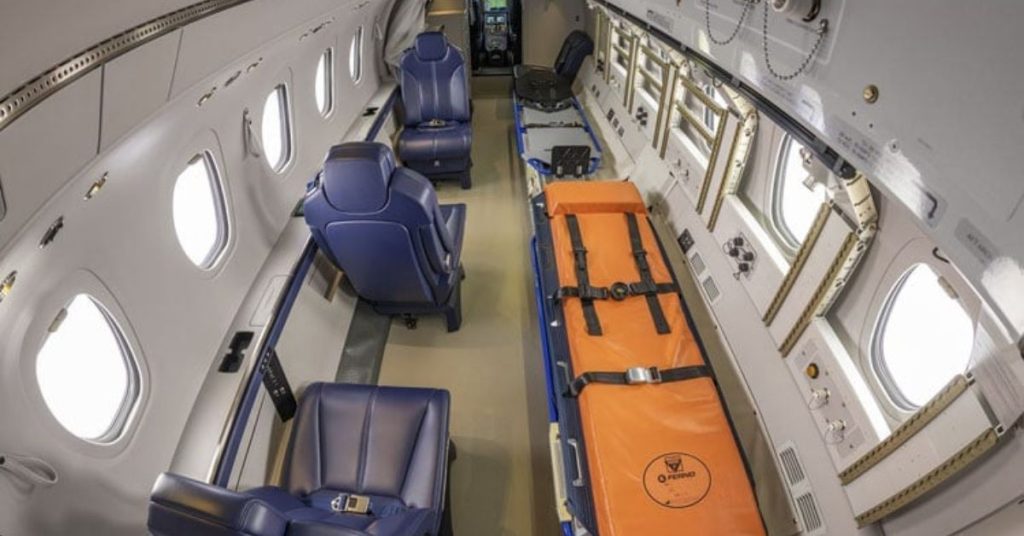
Market Expansion into Tier-2 and Tier-3 Cities
Traditionally focused on metropolitan hubs, air ambulance providers are expanding coverage to tier-2 and tier-3 cities, addressing a critical gap in emergency healthcare access. Strategic partnerships with regional hospitals and local governments are enabling service penetration into these growing markets. This expansion aligns with India’s broader healthcare infrastructure development and increasing insurance penetration.
Sustainability and Green Aviation Initiatives
Sustainability is emerging as a priority in private aviation, including air ambulance services. Providers are exploring fuel-efficient aircraft, hybrid propulsion systems, and carbon offset programs to reduce environmental impact. These initiatives respond to growing regulatory scrutiny and corporate social responsibility imperatives within the healthcare and aviation sectors.
Collaboration Between Healthcare Providers and Aviation Firms
Integrated care models are becoming standard, with healthcare providers partnering closely with private aviation firms to streamline patient transfer protocols. These collaborations facilitate seamless coordination across referral hospitals, emergency response teams, and air ambulance operators, minimizing delays and optimizing resource utilization.
Strategic Recommendations for Selecting the Best Air Ambulance Service
Selecting the best air ambulance service in India requires a strategic evaluation of multiple factors to ensure optimal patient outcomes, cost efficiency, and operational reliability. Decision-makers—whether healthcare providers, insurers, or patients—should prioritize the following criteria:
1. Accreditation and Compliance
Choose providers with certifications from the Directorate General of Civil Aviation (DGCA) and healthcare accreditations such as NABH or ISO standards. These certifications guarantee adherence to stringent safety protocols, medical standards, and aircraft maintenance.
2. Fleet Diversity and Medical Capabilities
A versatile fleet combining fixed-wing jets and helicopters allows flexible responses tailored to geographic and clinical requirements. Assess the availability of advanced life support air ambulance systems, onboard ICU facilities, and the expertise of the medical crew to meet specific patient needs.
3. Response Time and Geographic Coverage
Evaluate average response and mobilization times, especially in regions with high patient transfer demand. Providers with extensive networks covering metropolitan and remote areas ensure timely emergency medical air transport and reduce critical delays.
4. Cost Efficiency and Insurance Support
Balance service quality with cost considerations. Understand pricing structures, including base charges, distance surcharges, and medical crew fees. Confirm the extent of insurance coverage or reimbursement options to mitigate out-of-pocket expenses.
5. Technological Integration and Innovation
Select providers leveraging telemedicine, AI-enabled monitoring, and real-time data sharing to enhance in-flight care quality and communication with receiving hospitals. Technological adoption is a strong indicator of service reliability and clinical excellence.
6. Future-proofing and Scalability
Consider the provider’s commitment to sustainability, fleet modernization, and market expansion. A future-ready service can adapt to evolving healthcare demands, regulatory changes, and technological advancements.
Conclusion
The air ambulance sector in India is a rapidly evolving domain, integral to the country’s emergency healthcare infrastructure. Through the strategic integration of private aviation, advanced medical technologies, and expanding geographic coverage, the industry continues to improve patient outcomes and accessibility. Analysis of the best air ambulance service in India highlights the critical importance of fleet diversity, medical capabilities, rapid response times, and cost efficiency.
Private air ambulance providers such as Med-Trans Air Ambulance, Global Air Ambulance, and Flyjet Air Ambulance set industry benchmarks by combining clinical excellence with operational agility and technological innovation. Cost-benefit evaluations confirm that while air ambulance services command premium pricing, the substantial time savings and improved clinical outcomes justify the investment, especially in time-critical cases.
Emerging trends—such as luxury air ambulance offerings, telemedicine integration, AI-enabled monitoring, and sustainability initiatives—underscore the sector’s dynamic nature and future growth potential. For hospitals, insurers, and patients, making informed decisions based on accreditation, service quality, technological capability, and financial considerations is essential to leveraging the full benefits of air medical transport.
As India’s healthcare landscape expands, the role of private aviation in air ambulance services will become increasingly pivotal, offering scalable, high-quality emergency medical transport solutions across urban and rural regions. Continued innovation and strategic partnerships will further position air ambulance services as a cornerstone of India’s emergency response ecosystem.
We welcome your insights and experiences!
If you’ve used or worked with air ambulance services in India, please share your thoughts and feedback in the comments below. Your input helps create a more informed community and supports others in making critical healthcare decisions.





